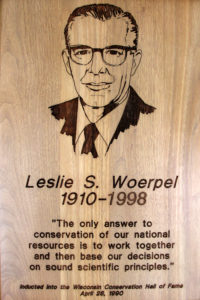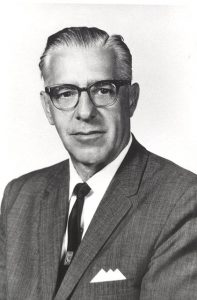“We do not claim to have done any of these jobs alone. The organization which claims sole responsibility is prevaricating.” — Les Woerpel
Wisconsin’s conservation legacy is rich with examples of enlightened citizens who worked tirelessly for the cause. Les Woerpel is such a man. He wasn’t a conservationist by profession, nor was he a public official.
He made his living working for AT&T, but Les Woerpel’s heart was in conservation, and his accomplishments are many. He was feisty, driven and dedicated. The Sun Prairie native lived in Stevens Point for many years, and his own conservation story begins there.
In 1949, representatives of 29 clubs with nearly 20,000 members met in Stevens Point to form the Wisconsin Federation of Conservation Clubs. Les Woerpel was elected the group’s first president. He later became its executive director, and he devoted a quarter century to the group’s causes. WFCC later became the Wisconsin Wildlife Federation, a group still active in conservation causes.
Under Woerpel’s leadership, WFCC shaped Wisconsin’s conservation policies in several areas. The group helped defeat a bill in the Legislature that would have allowed counties to set their own deer hunting regulations. Woerpel and the group stood by the principles of good wildlife management, not always easy on the explosive issue of Wisconsin’s deer herd.
 Even before his involvement with WFCC, Woerpel was a leader in efforts to save Wisconsin’s remnant prairie chicken population. Then, with Woerpel as its leader, the WFCC led efforts to establish the state’s prairie chicken research project. That project was overseen for many years by two other Conservation Hall of Fame inductees, Frederick and Frances Hamerstrom. The very survival of the prairie chicken in Wisconsin can be traced to Woerpel’s efforts.
Even before his involvement with WFCC, Woerpel was a leader in efforts to save Wisconsin’s remnant prairie chicken population. Then, with Woerpel as its leader, the WFCC led efforts to establish the state’s prairie chicken research project. That project was overseen for many years by two other Conservation Hall of Fame inductees, Frederick and Frances Hamerstrom. The very survival of the prairie chicken in Wisconsin can be traced to Woerpel’s efforts.
Individually and as a conservation organization leader, Woerpel played a crucial role in opposing the creation of a reservoir on the Little Eau Pleine River in Marathon, Wood and Portage counties. He contended that it would flood outstanding wildlife habitat. Eventually, plans for the resevoir were abandoned. The land is now the 28,000-acre Mead Wildlife Area, home for a multitude of upland and lowland game and nongame species.
Resources
Leslie Woerpel Legislative Citation
WCHF Induction speech by Woerpel’s son, Loren S. Woerpel, 1990
Leslie Woerpel Induction article, 1990
Little Eau Pleine Reservior articles by Leslie Woerpel, 1955
Personal account of viewing Prairie Chickens at the Hamerstroms by Leslie Woerpel
Photos
These images may be used under the Creative Commons Attribution-NonCommercial-NoDerivatives 4.0 International License.











